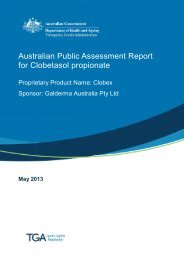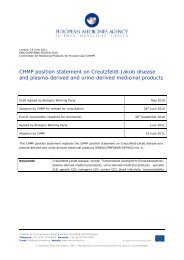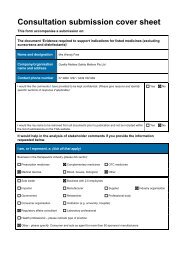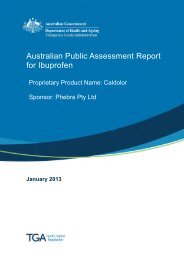AusPAR: Ivabradine - Therapeutic Goods Administration
AusPAR: Ivabradine - Therapeutic Goods Administration
AusPAR: Ivabradine - Therapeutic Goods Administration
You also want an ePaper? Increase the reach of your titles
YUMPU automatically turns print PDFs into web optimized ePapers that Google loves.
<strong>AusPAR</strong> Coralan <strong>Ivabradine</strong> Servier Laboratories (Australia) Pty Ltd PM-2010-03269-3-3<br />
Final 31 October 2012<br />
<strong>Therapeutic</strong> <strong>Goods</strong> <strong>Administration</strong><br />
Subgroup analysis of the secondary endpoints relating to mortality (death from any<br />
cause, cardiovascular death and death from heart failure) in the RS population showed an<br />
effect in favour of ivabradine in all the pre specified subgroups except in the subgroup of<br />
“baseline HR 0.05 in all pre-specified subgroups except for the subgroup on baseline HR (< 77 bpm<br />
versus ≥77 bpm), with p=0.0274 and p=0.0379 for each endpoint, respectively, showing a<br />
greater effect of ivabradine on the subgroup with baseline HR of ≥77 bpm than that with<br />
baseline HR of < 77 bpm. Analysis in the subgroup “age ≥ 75 years” (n = 722) was only<br />
presented for the endpoint of cardiovascular death and also showed an effect in favour of<br />
ivabradine, with an estimated hazard ratio of 0.71 (95% CI [0.51, 1.00]). No analysis for<br />
statistical significance was presented.<br />
For endpoints relating to hospitalisation (hospitalisation for any cause, hospitalisation for<br />
cardiovascular reason and hospitalisation for worsening heart failure), only subgroup<br />
analysis on hospitalisation for worsening heart failure was presented in the CSR and<br />
showed an effect in favour of ivabradine in all the pre specified subgroups. Subgroup<br />
interaction tests on the endpoint of hospitalisations for worsening heart failure yielded pvalues<br />
>0.05 in all pre specified subgroups except for the subgroup on ischaemic versus<br />
non-ischaemic cause, with p=0.0345, showing that ivabradine had a statistically<br />
significantly greater effect on patients with CHF from an ischaemic cause compared to<br />
those with CHF from a non-ischaemic cause. Analyses on hospitalisation for worsening<br />
heart failure in the subgroup “age ≥75 years” also showed an effect in favour of ivabradine,<br />
with a hazard ratio of 0.92 (95% CI [0.68, 1.23]). No analysis for statistical significance<br />
was presented. 25<br />
Analysis in the RSBBdose population of the secondary endpoints relating to mortality<br />
showed that differences between treatment groups in the endpoints of deaths from heart<br />
failure, cardiovascular deaths and death from any cause were all found to be not<br />
statistically significant (p=0.438 to 0.986) (Tables 6 and 7). Analysis in the RSBBdose<br />
population of the secondary endpoints relating to hospitalisations showed that differences<br />
between treatment groups in the endpoints of hospitalisation for worsening heart failure<br />
and cardiovascular hospitalisation were statistically significant in favour of ivabradine<br />
(hazard ratios of 0.81 [p= 0.0211] and 0.88 [p=0.0464], respectively) but that for<br />
hospitalisation for any cause was not statistically significant (p=0.081) (Tables 8 and 9).<br />
25 Sponsor comment: “95% confidence intervals were indeed presented demonstrating no statistical<br />
significance.”<br />
Page 24 of 101
















